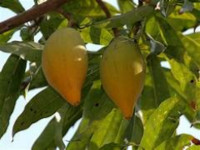Total Carotenoid Content and Antioxidant Activity of Sawo Walanda (Pouteria campechiana Kunth. Baehni) Extract from Various Solvents http://www.doi.org/10.26538/tjnpr/v7i7.28
Main Article Content
Abstract
Pouteria campechiana, also known as sawo walanda in Indonesia, is known for its high abundance of carotenoids, which are recognized for their antioxidant properties. The extraction of these constituents involves a crucial step of selecting an appropriate solvent, as indicated by several studies. Therefore, this study aims to assess the antioxidant activity as well as determine the total
carotenoid content of P. campechiana fruit and leaf extract in various solvents. The study methodology involved extraction using the maceration method with n-hexane and ethyl acetate as solvents. Antioxidant activity and determination of total carotenoid were carried out using UVVissible spectrophotometry. DPPH was used as a free radical, while ß-carotene served as the standard for total carotenoid content. The results showed that n-hexane fruit (NF) extract had the highest total carotenoid concentration (70.028 gBEQ/100 g extract), while n-hexane leaf (NL) extract had the lowest (39.540 gBEQ/100 g extract). Ethyl acetate leaf (EL) extract exhibited better antioxidant activity with IC50 of 3.094 µg/mL±0.82 compared to NL (9.270 µg/mL±1.201), ethyl acetate fruit (EF) (31.516 µg/mL±1.786), and NF (45.382 µg/mL±2.31) extracts. Based on the statistical analysis results, the coefficient correlation of total carotenoid content with IC50 DPPH was r = 0.855, p<0.01. This indicated that an increase in total carotenoid content did not always lead to a proportional increment in the inhibition of DPPH. These findings revealed that n-hexane solvent was more suitable for extracting carotenoids from the fruit part, while ethyl acetate was more appropriate for the leaf. Furthermore, the fruit and leaf extract of P. campechiana had potential antioxidant activity as natural ingredients in the food and pharmaceutical industries.
Downloads
Article Details

This work is licensed under a Creative Commons Attribution-NonCommercial-NoDerivatives 4.0 International License.
References
Silva, CAM, Simeoni LA, Silveira D. Genus Pouteria: chemistry and biological activity. Rev. Bras. Farmacogn.
; 19(2A): 501–509.
Kanak-A F, Bakar MFA. Canistel-Pouteria campechiana (Kunth) Behni. Academic Press; 2018;107-111.
Kubola J, Siriamornpun S, Meeso N. Phytochemicals, vitamin C and sugar content of Thai wild fruits. Food Chem. 2011;126(3):972–981.
Aseervatham GSB, Sivasudha T, Sasikumar JM, Christabel HP, Jeya D, Ananth AD. Antioxidant and hepatoprotective potential of Pouteria campechiana on acetaminopheninduced hepatic toxicity in rats. J. Physiol. Biochem. 2014;(70):1–14.
Costa TS, Lopes R, Wondracek D, Vileria R. Carotenoids composition of canistel (Pouteria campechiana (Kunth.) Behni.). Revista Brasileria de Fruticultura. 2010;32(3):903- 906.
Aulifa DL, Fitriansyah SN, Ardiansyah SA, Wibowo DP, Armiliani Y, and Christy DS. Phytochemical screening, antibacterial activity, and mode of action on Morus nigra. Pharmacogn J. 2018; 10(1): 167-171.
Fidrianny, I., Suhendy, H., Insanu, M. Correlation of phytochemical content with antioxidant potential of various sweet potato (Ipomea batatas) in West Java, Indonesia, Asian Pacific Journal of Tropical Biomedicine. 2018;8(1):25-30.
Scherer R, Godoy HT. Antioxidant activity index (AAI) by the 2,2-diphenil-1-picrylhydrazyl method. Food Chem.2009;112:654-658.
Thaipong K, Boonprakob U, Crosby K, Zevallos LC, Byrne DH. Comparison of ABTS, DPPH, FRAP, and ORAC assayfor estimating antioxidant activity from guava fruit extracts. J Food Comp Anal. 2006;19:669- 675.
Hartati R, Nadifan HI, Fidrianny I. Crystal guava (Psidium guajava L. “Crystal”): evaluation in vitro antioxidant capacities and phytochemical content. Sci. World J. 2020; vol 2020:1-7.
Baky MH, Kamal AK, Elgindi MR, Haggag EG. A review on phenolic compounds from family sapotaceae. J Pharmacogn Phytochem. 2016;5(2):280-7.
Lanerolle, S.de M, Priyadarshani, A.M.B, Sumithraarachchi, D.B, and Jansz, E.R. The carotenoids of Pouteria campechiana (Sinhala: ratalawulu). J.Natn.Sci. 2008;36(1):95-98.
Ma J, Yang H, Basile MJ, Kennelly EJ. Analysis of polyphenolic antioxidants from the fruit of three Pouteria species by selected ion monitoring liquid chromatographymass spectrometry. J Agric Food Chem. 2004;52(19):873- 878.
Sangeetha R, Pratheeba T, Ragavendran C, Natarajan D. Pouteria campechiana leaf extract and its bioactive compound myricitrin are mosquitocidal against Aedes aegypti and Culex quinquefasciatus. Asian Pac. J. Trop. Med. 2019;12(7):321–328.
Matsushita Y, Suzuki R, Nara E, Yokoyama A, Miyashita K. Antioxidant activity of polar carotenoids including astaxanthin-b-glucoside from marine bacterium on PC liposomes. Fisheries Sci. 2000;66:980-985.
Saini, R.K, Keum Y-S. Carotenoid extraction methods: a review of recent developments. Food Chemistry. 2017;(7):1- 50.
Amorim-Carrilho, KT, Cepeda A, Fente C, Regal P. Review of methods for analysis of carotenoids. Trends Analyt Chem. 2014;(56):49–73.
Ragasa CY, Labaclado LM, Rideout JA. Triterpenes and sterol from Pouteria campechiana. Philipp J. Sci. 2011;6(2):1–7.
Puspita D, Kurniawan YA, Aiboi Y. Kandungan KArotenoid Mentega dari Sawo Keju (Pouteria campechiana). J Food and Nutr. Sci. 2019;3(1):1-9.
Fitriansyah SN, Hartati I, Fidrianny I. Effect of Different Solvent on Phytochemical Content, Tyrosinase Inhibition and Antioxidant Activities of Campolay (Pouteria campechaina Kunth. Baehni.). Open Acces Maced J Med Sci. 2022;10(A):158-163.
Hidayah N, Aulifa DL, Fitriansyah SN. Determination of Total Phenolic, Flavonoid Content and Antioxidant Activity of Campolay (Pouteria campechiana). Advances in Health Sciences Research. 2020;26:107-109.
Kalpana B, Vijay DW, Sanjay ST, Bhushan RS. Phytochemical, antimicrobial evaluation and determination of total phenolic and flavonoid contents of Sesbania grandiflora flower extract. Int J Pharm Pharm Sci. 2012;4(4):229-232
Fiedor J, Burda K. Potential role of carotenoids as antioxidant in human health and disease. Nutrients.2014;6:466-488.
Sirvastava, R. Physicochemical, antioxidant properties of carotenoids and its optoelectronic and interaction studies with chlorophyll pigments. Scientific Reports. 2011; 11(18365):1-14.
Neeraj KS, Partap S, Priyanka, Keshari JK, Herman KS, Anil KS. Free radical scavenging activity of methanolic extract of Luffa cylindrica leaves. Int J Green Pharm. 2012;6(3): 231- 236
Fidrianny I, Aristya T, Hartati R. Antioxidant capacities of various leaves extracts from three species of legumes and correlation with total flavonoid, phenolic, carotenoid content. Int J Pharmacogn Phytochem Res. 2015;7(3):628- 634.


